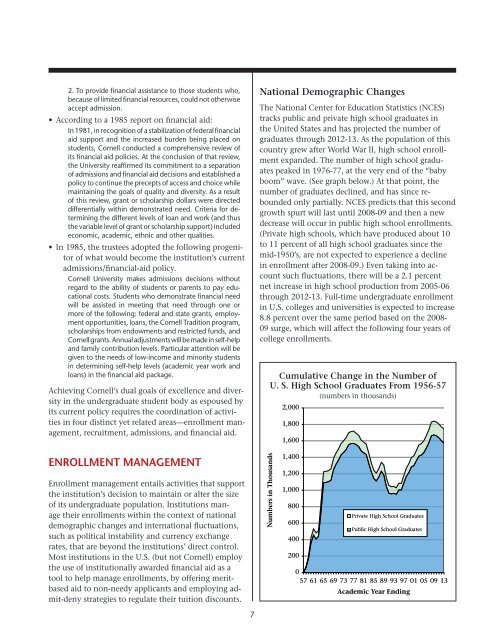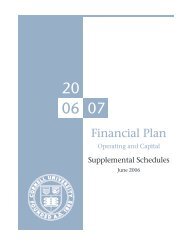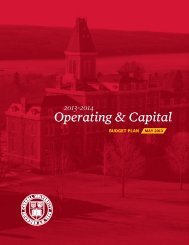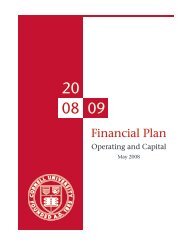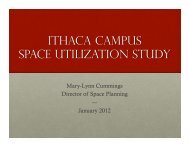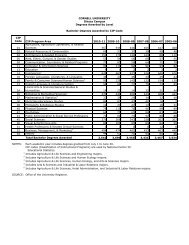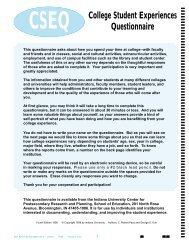Undergraduate Student Access - Cornell University Division of ...
Undergraduate Student Access - Cornell University Division of ...
Undergraduate Student Access - Cornell University Division of ...
You also want an ePaper? Increase the reach of your titles
YUMPU automatically turns print PDFs into web optimized ePapers that Google loves.
2. To provide financial assistance to those students who,because <strong>of</strong> limited financial resources, could not otherwiseaccept admission.• According to a 1985 report on financial aid:In 1981, in recognition <strong>of</strong> a stabilization <strong>of</strong> federal financialaid support and the increased burden being placed onstudents, <strong>Cornell</strong> conducted a comprehensive review <strong>of</strong>its financial aid policies. At the conclusion <strong>of</strong> that review,the <strong>University</strong> reaffirmed its commitment to a separation<strong>of</strong> admissions and financial aid decisions and established apolicy to continue the precepts <strong>of</strong> access and choice whilemaintaining the goals <strong>of</strong> quality and diversity. As a result<strong>of</strong> this review, grant or scholarship dollars were directeddifferentially within demonstrated need. Criteria for determiningthe different levels <strong>of</strong> loan and work (and thusthe variable level <strong>of</strong> grant or scholarship support) includedeconomic, academic, ethnic and other qualities.• In 1985, the trustees adopted the following progenitor<strong>of</strong> what would become the institution’s currentadmissions/financial-aid policy.<strong>Cornell</strong> <strong>University</strong> makes admissions decisions withoutregard to the ability <strong>of</strong> students or parents to pay educationalcosts. <strong>Student</strong>s who demonstrate financial needwill be assisted in meeting that need through one ormore <strong>of</strong> the following: federal and state grants, employmentopportunities, loans, the <strong>Cornell</strong> Tradition program,scholarships from endowments and restricted funds, and<strong>Cornell</strong> grants. Annual adjustments will be made in self-helpand family contribution levels. Particular attention will begiven to the needs <strong>of</strong> low-income and minority studentsin determining self-help levels (academic year work andloans) in the financial aid package.Achieving <strong>Cornell</strong>’s dual goals <strong>of</strong> excellence and diversityin the undergraduate student body as espoused byits current policy requires the coordination <strong>of</strong> activitiesin four distinct yet related areas—enrollment management,recruitment, admissions, and financial aid.National Demographic ChangesThe National Center for Education Statistics (NCES)tracks public and private high school graduates inthe United States and has projected the number <strong>of</strong>graduates through 2012-13. As the population <strong>of</strong> thiscountry grew after World War II, high school enrollmentexpanded. The number <strong>of</strong> high school graduatespeaked in 1976-77, at the very end <strong>of</strong> the “babyboom” wave. (See graph below.) At that point, thenumber <strong>of</strong> graduates declined, and has since reboundedonly partially. NCES predicts that this secondgrowth spurt will last until 2008-09 and then a newdecrease will occur in public high school enrollments.(Private high schools, which have produced about 10to 11 percent <strong>of</strong> all high school graduates since themid-1950’s, are not expected to experience a declinein enrollment after 2008-09.) Even taking into accountsuch fluctuations, there will be a 2.1 percentnet increase in high school production from 2005-06through 2012-13. Full-time undergraduate enrollmentin U.S. colleges and universities is expected to increase8.8 percent over the same period based on the 2008-09 surge, which will affect the following four years <strong>of</strong>college enrollments.Cumulative Change in the Number <strong>of</strong>U. S. High School Graduates From 1956-57(numbers in thousands)2,0001,8001,600ENROLLMENT MANAGEMENTEnrollment management entails activities that supportthe institution’s decision to maintain or alter the size<strong>of</strong> its undergraduate population. Institutions managetheir enrollments within the context <strong>of</strong> nationaldemographic changes and international fluctuations,such as political instability and currency exchangerates, that are beyond the institutions’ direct control.Most institutions in the U.S. (but not <strong>Cornell</strong>) employthe use <strong>of</strong> institutionally awarded financial aid as atool to help manage enrollments, by <strong>of</strong>fering meritbasedaid to non-needy applicants and employing admit-denystrategies to regulate their tuition discounts.Numbers in Thousands1,4001,2001,000800Private High School Graduates600Public High School Graduates400200057 61 65 69 73 77 81 85 89 93 97 01 05 09 13Academic Year Ending7


